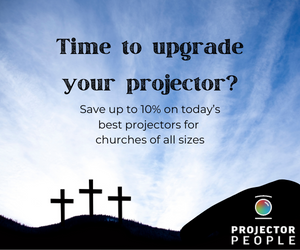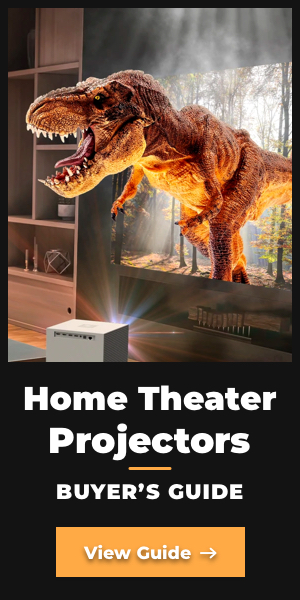Highly Recommended Award
Our Highly Recommended designation is earned by products offering extraordinary value or performance in their price class.
- Innovative modular, swiveling design
- Fast focusing with auto leveling and keystone
- Good color by default with extensive calibration controls
- Samsung smart TV features
- Wide selection of apps with HDR support including Netflix
- Excellent sharpness and uniformity
- Also a smart speaker and a lamp
- Ambient mode that lets you load your own images
- Nearly silent
- Not as bright as some latest generation compact projectors
- No 3.5mm audio input
- Does not accept a 4K signal
Samsung's new projector, The Freestyle, squeezes sophisticated picture processing, a long-life LED light source, and extensive smart TV capabilities into a compact body that's purpose-designed for flexibility and portability.
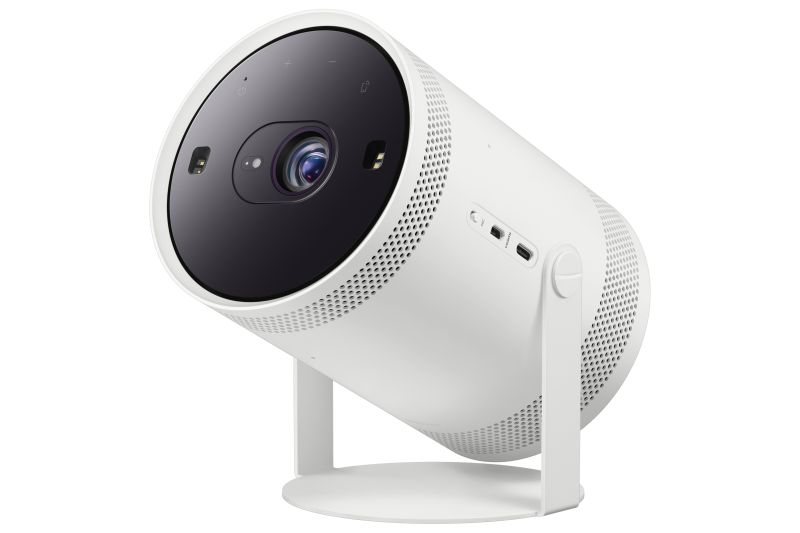
Samsung's recent reentry into projection has borne new fruit in the form of The Freestyle, a truly portable projector that offers a fresh take on what a display device should be able to do. Priced at $899, it looks like a toy, but it's a serious piece of hardware that leverages Samsung's smart TV platform and even its calibration tools to create something that feels new. Oh, and in addition to acting as a projector, it's a full-fledged smart speaker, as well as a colorful and programmable ambient light source. In other words, it's refreshingly fun!
Tucked inside a cylindrical chassis that looks a lot like a tabletop spotlight are a projector, a speaker system, a far-field mic array, and Samsung's smart TV platform, including picture processing capabilities and even auto-calibration (with compatible phones). The exterior of the projector is covered with a soft and flexible rubber-like material that should offer resistance against minor bumps and scrapes. The front of the unit, where the lens is located, has touch-sensitive controls for power and volume as well as a spot to tap for easily connecting smartphones.
Samsung's marketing for The Freestyle makes it abundantly clear this is not a device designed for any permanent installation. The product video is full of teenagers running around, projecting images on buildings and each other, or a ceiling, or the floor. Anything goes with The Freestyle, which can use any of four different power sources. While it does not have a built-in battery, an add-on rechargeable battery attaches to the bottom of the unit. Moreover, it is USB-C powered, and it'll run for several hours off a suitably powerful power bank (50W PD power). Of course, you can plug it into a wall outlet; the USB-C AC adapter it ships with is small and easily fits in a pocket.
This portable projector is different from any other that I'm familiar with because it is so adaptable to various novel uses. It's not merely that it resembles a lamp; it's able to act as a lamp thanks to an included diffuser cap. And with an optional adapter, you can even screw it into a light socket and use that as the power source while projecting down. Why would you project down, you might ask? Samsung suggests The Freestyle could be used as a "virtual sketchbook," basically turning blank sheets of paper into a coloring book.
Whatever you aim at, the projector adapts the picture by focusing and automatically applying keystone correction. You wouldn't do this if you wanted to get maximum quality (namely the highest possible resolution and brightness) out of any projector, but sometimes portability, convenience, and ease of use matter as much or more as ultimate picture quality, and those are the moments this projector is perfect for.
Features
Upon first glance at the specifications, it's easy to underestimate The Freestyle. The video capabilities are somewhat modest; it's a 1080p LED projector that outputs perhaps 250 ANSI lumens (though keep in mind that LED projection is said to be perceived brighter than it traditionally measures). The projector has a single mini-HDMI jack and no physical outputs. This is a compact DLP, and the lens lacks any zoom or shift capability; instead, it relies on digital scaling and perspective correction to put an image where you want it.
But, raw video specifications constitute half the story, or perhaps even less than half. What would normally be seen as limitations in many other projectors are harnessed here in creative ways. The Freestyle comes jampacked with features, especially those of the smart variety, including some lifestyle-friendly functions that you don't see on other projectors. It's a unique design with modular add-on accessories and an included stand that makes it possible to aim a picture practically wherever you can find a flat surface.
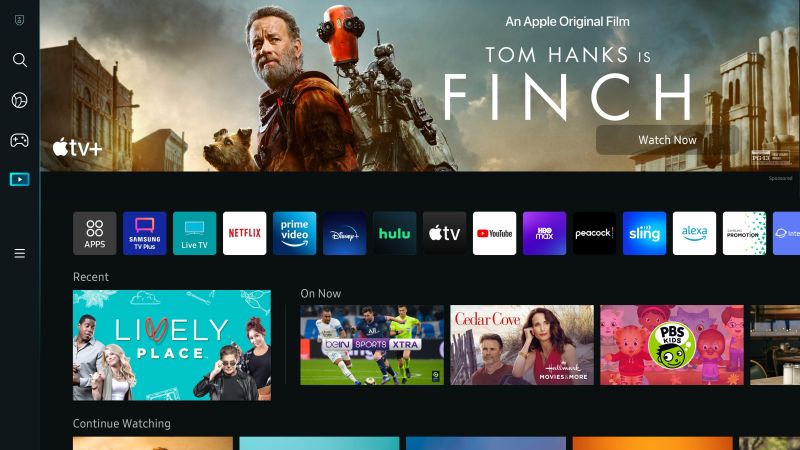
The Freestyle certainly benefits from being a Samsung. It has an OS taken from Samsung's Crystal LED TVs, which is based on Samsung's Tizen OS; it is speedy and offers a well thought out GUI. Perhaps most importantly, it offers popular streaming apps, including an authorized app for Netflix, which Android TV-based projectors often do not support. Moreover, The Freestyle is a smart speaker with an integrated far-field microphone array as well as voice search built into the Bluetooth remote.
The projector supports Amazon Alexa and Samsung's Bixby voice assistants. You can use the virtual assistant to control functions for video streams, music listening, and search for content. There's a physical switch to disable the far-field microphones if you want. And check this out: you can mirror on The Freestyle what's playing live on a compatible Samsung TV that's on the same Wi-Fi network. So you can, for example take the live sports event from your cable box that's playing on the TV in the living room and project it simultaneously from The Freestyle on a wall beside your barbeque in the back yard.
Samsung wanted to ensure that buyers of its TVs, and in this case, the projector, get live TV content right away, without having to do anything but connect to broadband. The result is Samsung TV Plus, "no strings attached" free TV with a rather robust content lineup including shows from the major networks. It's free, requires no signup, and it just works. There's a dedicated button for it on the remote, and you can change channels just like you would with a regular TV.
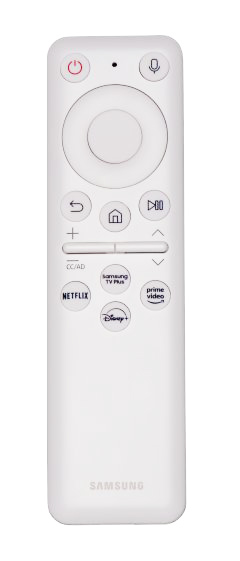
You can also control the projector from the Samsung SmartThings app, including using one of the more interesting features of this projector: cellphone-based auto-calibration. Beyond auto-calibration, this projector has the full grayscale and gamma calibration controls found on Samsung's better TVs, including two-point, 10-point, and 20-point adjustments, as well as separate CMS controls. It's entirely possible to calibrate this projector to a high degree of accuracy if you wanted to use it as a portable monitor or otherwise enjoy accurate color out of it. And this is on top of the fact that the picture looks good, albeit not necessarily accurate, right out of the box.
While wireless connectivity is a major part of this projector's feature set, The Freestyle has a micro-HDMI input supporting 1080p signals up to 60 Hz. This is handy for connecting a gaming console or laptop, or perhaps a cable box or streaming stick using an appropriate adapter or cable. The projector also has a dedicated Game Mode.
One thing that's missing here is any discrete audio output, such as a 3.5 mm aux/headphone jack or optical digital. But again, in the context of what Samsung seeks to achieve with this design, tying down this projector with cable connections was not the objective. It's envisioned as a device that spends much of its time connected wirelessly and used in various contexts as a standalone device. That said, you can use HDMI ARC to send audio from the projector to an AVR or soundbar, and it also works with Bluetooth speakers, so you do have more options than just the built-in audio.
Speaking of which, the onboard sound system is surprisingly robust—at least for this size device. Samsung skips the stereo sound and instead uses a single 5-watt driver with 360-degree dispersion that fires from the back of the projector; bass is augmented by dual force-canceling passive radiators. The main benefit is that it can play loud and clear, at least compared to your typical portable projector.
I was not supplied with add-on accessories with my Freestyle sample, such as the bulb socket adapter, attachable battery, or travel pouch. This review covers the projector itself with the included swiveling cradle stand, translucent lens cap, and USB-C power adapter.
Performance
SDR Picture Modes. The Freestyle provides four picture modes: Dynamic, Standard, Movie, and Game. The Game Mode function reduces latency from about 70 milliseconds to 43.2 ms with a 1080p 60 Hz input. That's not amazing, but it is fine for casual gaming and certainly better than the 70 ms or so delay when game mode is not active. One minor annoyance is that activating Game mode requires a quick trip to a different submenu called "Connections" instead of being available under Picture Mode in the regular Picture settings.
As you might expect, Dynamic is among the brightest modes available by default on the projector, however it is matched in brightness by the Game Mode default settings. These two modes are only marginally brighter than the Standard mode default, which is only marginally brighter than the Movie mode.
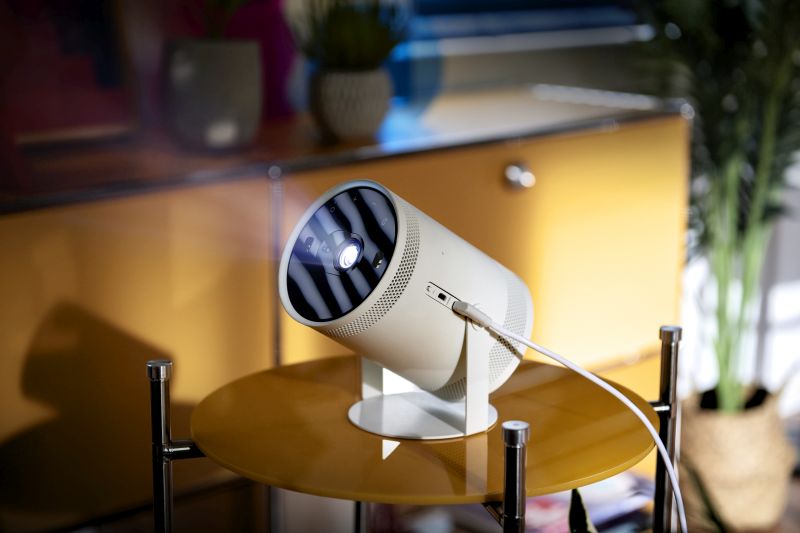
Dynamic picture mode uses the "Cool" color tone by default and clips some highlight detail. Still, it is perfectly usable in a situation where you want maximum light output above all. But, because Standard mode is capable of getting as bright (if you turn the Brightness control up to 50) and is more accurate; it's the solid choice for general purpose use.
Standard picture mode uses the Standard color tone setting by default, which is still cool (7,971K) when measured but very neutral on screen, with peak pure whites that look like snow and grays with no visible color cast. Though it is not as bright as Dynamic by default, you can adjust the projector's Brightness setting from the Standard mode default of 35 to the maximum of 50, at which point it is incredibly close to Dynamic mode in terms of peak brightness. Both Standard or Dynamic provide for two-point grayscale calibration.
As noted, the Movie mode on this projector is a bit dimmer than the other modes, by about 20%. By default, this mode uses the Warm2 color tone, which I measured at 5,663K. That is actually too warm (or pink-leaning). Even the Warm1 setting was too warm and measured at 5,811K. On the other hand, gamma measured near-perfect at 2.17 (the ideal target is 2.2 for a dim room) regardless of the chosen color tone setting.
So, what to do? Well, the first thing to do is remember that this is a new projector that may benefit from future firmware upgrades that improve the out-of-box image accuracy. But perhaps the best advice may be to keep things in perspective here. This is a unique lifestyle projector designed for casual viewing, and the vast majority of users will likely find the default picture settings more than acceptable. Few if any will ever pay for a professional calibration, and most won't even bother with the available auto-calibration features. That said, it's amazing to see this degree of control in a projector of this type, so for those interested, I'll report on my experience using the auto-cal function and calibrating manually with my colorimeter and the two-point grayscale adjustments.
To begin, Movie mode offers 2-point, 10-point, and 20-point white balance/grayscale adjustment, and it all works properly—spend enough time calibrating, and you can get essentially perfect accuracy out of it (or at least technically beyond the threshold of human perception). But you get really good results with just using the two-point adjustment on this projector. The separate gamma control practically negates the need to dig into the 10-point or 20-point controls except for specific usage scenarios where color accuracy is critical.
The automatic calibration function, if you go that route, requires a compatible cell phone; I used a Samsung Galaxy S21 Ultra. With the automatic calibration, you don't need to worry about 2-point, 10-point, or any of that. You don't need to own a colorimeter, pattern generator, or calibration software. All you need to do is launch an app, aim the phone's camera at the screen, and let it run. The word "Calibrated" appears next to Movie in the mode selection menu when it's done.
However, after running the auto-cal off a white screen I found the result still too warm; the process set the color tone to Warm2, and it measured 5,850K—better than the default but not truly accurate. The best use I see for the auto-calibration is when you deal with an off-white projection surface, such as a tinted wall, and use it to compensate for that. For "regular" use, I suggest the Standard mode with its cooler color temperature and more neutral look; it offers greater overall versatility. (FWIW, Game Mode looks almost exactly like Standard in terms of color settings). But the good news is that Samsung provides you with useful tools to optimize The Freestyle's picture if you want to.
The end result is that the cellphone calibration is quick and easy and gives you an incremental improvement, but a proper calibration pushes this projector far closer to a truly accurate image. So, to get the color where I wanted I started by resetting the Movie mode to defaults. I set the color tone to Warm1, then used the 2-point color adjustment to dial in the right 6,500K color temperature. Final settings under the White Balance 2-point menu were: Gain at R -15, G -17, B +6 and Offset at R -2, G +1, B +2. It turns out the shadows were already close to accurate; it's the highlights that required some significant adjustment to get right. But the result, after just a couple of minutes of tweaking the 2-point controls, was simply spectacular. I wish all projectors were this easy to calibrate.
Worth noting: Under color space settings (CMS), I chose "Auto," and according to my measurements using Portrait Displays' Calman color calibration software, Rec.709 coverage is 99%, which in effect is 100%. Color points are very close to accurate without any adjustment. However, a dedicated hobbyist or professional could certainly spend a few minutes to get it exactly perfect (for a given projection surface, anyhow).
The average post-calibration DeltaE of the grayscale (a measure of accuracy) wound up at 1.6, which qualifies as fully calibrated. Color temp wound up at 6,493K, just about perfect. Gamma was 2.18, just a hair under the 2.2 goal. Plus, there was no penalty in light output versus the Movie mode defaults while achieving this high degree of accuracy. Regarding what I was looking at, the 22-inch diagonal screen had peak highlights of 415 nits; the projector can produce that across the full-screen and do so indefinitely. Some projectors take a huge hit in output to achieve an accurate result if they can even get there at all.
HDR Picture Modes. The 1080p Freestyle processes HDR and 10-bit video if it's delivered via the streaming platform, but it lacks sufficient brightness or contrast to produce an HDR effect on a big screen. On the unit I reviewed, which is still pre-production, the mini-HDMI did not yet communicate properly with the Xbox Series X, or PCs, in order to enable support for HDR at 1080P. Samsung is working with Microsoft and anticipates having the issue resolved when the projector ships. Despite the limited brightness, there's still a benefit to HDR, thanks to richer colors and smoother gradients. Technically, the projector covers 82% of the DCI-P3 color space, per my measurements using CalMan software.
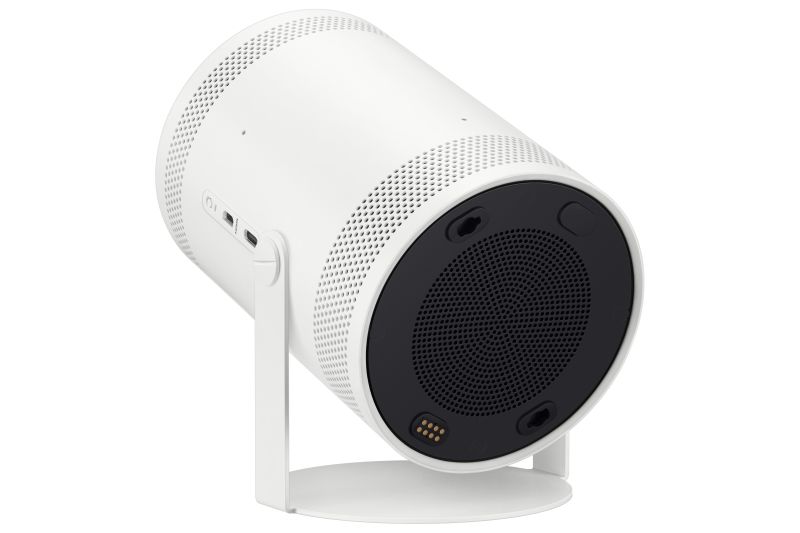
The HDR picture modes are the same as the SDR picture modes: Dynamic, Standard, Movie, and Game. With smaller image sizes, there is enough Brightness to render HDR. Arguably, when streaming, you get the best picture quality with HDR because the source material is 10-bit and has a wider color gamut (if HDR is supported at HD resolution at all; not all apps/streaming services do). But to reiterate what I said earlier about the intended use, this is not the right projector to be sweating how well it handles HDR. That it does at all is purely a bonus, IMO. I'm personally more excited that it can truly "nail" SDR rec.709 with high accuracy.
SDR Home Theater. Ordinarily, when reviewing a projector, I perform an optimized setup and basically don't touch the projector for the remainder of the review. But for this review, part of the point is to see how the projector performs when adapting to different surfaces and screen sizes. In other words, its adaptability and portability are sort of the whole point.
So let's start with the most traditional use for a projector, which is putting a big picture up on the wall, or preferably on a screen. I used a 100-inch, 16:9 Elite Screens with CineWhite 1.1-gain material for this task. This represents the maximum screen size that Samsung advertises for this projector, and it is stretching the projector's capabilities to push it this far. Still, suppose you turn out the lights. In that case, one is easily reminded that your eyes can adapt, so even though it's fairly dim, you can appreciate how well it renders 1080p with pleasing color right out of the box in Standard mode, with excellent sharpness, smooth motion, and no banding artifacts.
So what to watch? Vudu is my go-to streaming service for movies, and I own close to 300 titles and have rented many more. I decided to take in some scenes from No Time to Die and Shang-Chi and the Legend of the Ten Rings. While I could tell these were not UHD streams, the overall quality left me more than a bit impressed. Motion resolution is good, as expected from DLP, and holds up well with a lot of action on screen.
This Samsung has the general look and feel of a Samsung TV in terms of color balance, which I'd attribute to the picture processing and tuning. And the sharpness—the apparent resolution on screen—kept surprising me, which I attribute to Samsung using a very sharp lens. If you magnify the pixel grid, each pixel is very clearly defined, even in the corners, as you'd expect from a flat-panel television but not necessarily from a compact lifestyle projector. And the quality of the lens itself goes a long way to making this projector usable as a computer display because that sharpness translates to easily readable text.
If you're interested in using The Freestyle for home theater, the optimal screen size is around 70 or 75 inches for a 1.0 or 1.1 gain screen. At this size, the peak luminance, calibrated in Movie mode, is a near-perfect match for the DCI-P3 standard used in movie theaters, which is 48 nits. And if you run the projector with the cooler color temperature of the Standard color tone setting, you can bump the screen size up to about 85 inches and still have appropriate brightness for dark room, home theater-style viewing. I wouldn't use it as a primary display, but still, when I watched parts of one of my all-time favorite movies, Starship Troopers, on "regular" Blu-ray, I was impressed not only by how well it handled space scenes and the space battles, but also how it made the later scenes on the sunbaked surface of planet Klendathu look appropriately hot and dry. And there certainly was plenty of detail to appreciate during the numerous gross-out effects throughout the movie ("They sucked his brains out," being my favorite moment).

Even as a jaded home theater veteran, I felt it was not too shabby a performance for a reasonably priced projector roughly the size of a coffee can, especially considering that the built-in fan is nearly silent (it's inaudible unless you put your ear right up next to the projector). I suspect if Samsung had made this projector much brighter than this, managing the heat would become a more significant challenge, and the power demands would have been higher. And yet, I would love to see Samsung create something along the lines of a Freestyle Pro at some point in the future.
If you are looking to emulate the brightness of a typical TV that's optimized for SDR viewing in evening ambient light, that's going to be around 100-nit peak luminance. And with the Standard picture mode with the Brightness turned up to 50, you get that on a typical white painted wall at approximately 55 or 60 inches diagonal. If you choose to use calibrated Movie mode instead, true TV-like brightness is achieved for an image size up to 50 inches, although you can get away with 55 inches. It would be best if you still dimmed the lights to get a punchy image, but this is the size where it looks almost like a TV. Also, buying a small ALR (ambient light rejecting) screen could be a good way to extend the utility of The Freestyle, especially for daytime viewing.
Monitor Viewing. Perhaps the most impressive application for this projector is creating the equivalent of a small flat panel screen. Samsung suggests using The Freestyle as a sort of portable monitor, and when I gave it a try, I was really surprised at the quality of the image. Shining directly on to a wall works great, though watch out for glossy paint; it'll have glare. But, for maximum impact, try using a piece of matte white posterboard or, better yet, a piece of 20 x 30-inch foam board. The smooth and neutral white surface of paper makes for a superbly detailed image that holds up well even under moderate ambient light and looks legitimately amazing under dim light.
The fun part about all this is how the projector immediately snaps into focus, and if you have automatic keystone correction enabled, it also compensates for poor placement. I like getting the most brightness and sharpness out of any projector, so I skipped the keystone and went with physically adjusting the projector to get it positioned properly. But I can see how in a pinch, you might want just to let it do its thing automatically, and if you bought this projector for kids, well, let's say it's immensely kid-friendly even though it's not a toy.
You can get more brightness from The Freestyle if you use it to project a small image, let's say the 30-inch diagonal that's advertised as the minimum. Note, you can also go smaller, much smaller. I found it'll still auto-focus when 6 inches from a surface or screen, resulting in a cell phone-sized, ultra-bright image. And while you may never need a projected image that small, in a pinch you can project onto a sheet of paper, even standard letter-size, and get a truly decent-looking picture out of it. If the projector is properly calibrated, it is no exaggeration to say that I'd be willing to color-correct photos using this because it is capable of tremendous accuracy. You'd just need to control ambient lighting and project on an appropriately smooth, white, neutral surface. The Freestyle truly has better calibration controls than most projectors, even dedicated home theater projectors that cost thousands of dollars.
Long story short: Employing this projector as a monitor substitute turns out to be a lot more viable than I had anticipated, and in some ways, the projector can outperform some computer monitors of a similar size. For example, no reflections are coming off the screen, and viewing angles are essentially perfect, even if your perspective is from the extreme edge of the screen.
Sharpness at smaller sizes is also exemplary, as is screen uniformity. The pixel grid is just about invisible, I'd argue more so than on flat-panel 1080p monitors. And it's pretty cool to be able to have the exact size you want; when it's recreating the equivalent of a 30- or 40-inch monitor, the projector has enough horsepower to create a compelling image. Above these sizes, however, the peak brightness drops off to the point where you lose the effect and it stops looking like a bright and contrasty flat-panel display.
So, here's my concrete, real-world, "Mark, would you do this in real life, not just for a review?" perspective. I took a 13 x 19-inch sheet of premium coated Epson fine art inkjet paper and used it as a screen to create a 21-inch diagonal image. I used that as a PC monitor to browse the web and work in Photoshop, and then I used it to play some Grand Theft Auto Online. While I was initially skeptical that you would use this projector as a PC monitor, after trying it, it seems like a no-brainer; if I had to give a presentation or just wanted a second monitor for my laptop on location, I'd toss The Freestyle into my backpack...where a standard monitor is certainly not going to fit! Another example of this small-screen application promoted by Samsung is to use The Freestyle in the kitchen to project recipes and how-to videos. You'd project an image onto a patch of blank wall instead of using a small TV, laptop, or tablet.
Ceiling Viewing. I was also skeptical about projecting onto the ceiling until I tried it myself. Samsung argues that you could use The Freestyle in bed instead of a smartphone or tablet. They even mention the benefit of not dozing off and dropping a device on your face! It's true; if you have a standard flat ceiling you can just put The Freestyle on the nightstand, aim it up, and doze off watching whatever.
By happy coincidence, I found there's more to projecting on the ceiling than having something to fall asleep to. In the living room, I discovered the pleasure of playing video games while lying down on the couch, without getting in the way of the basketball game on the main screen. Keep in mind that most homes have pictures or other obstructions on the walls. But a flat, smooth, white ceiling offers a large and unobstructed blank canvas. In my living room, putting The Freestyle on the coffee table and projecting to the 11-foot-high ceiling resulted in a 100-inch diagonal image that, similar to projecting on the Elite screen, is a bit dim by modern projectors standards. But it holds up great as long as you don't have a lot of ambient light for it to fight against. From a usability perspective, it's more important that the projector handles tonality well, rendering detail in the shadow regions and keeping the midtones reasonably bright—which you can do with the menu controls provided by Samsung or through an auto-calibration. I used this setup both for gaming and catching up on watching some YouTube videos I'd bookmarked. It's fun, and I was surprised how quickly I forgot I was looking at an image on the ceiling.
So, it's worth mentioning again that Netflix is built into the projector; it's kind of a big deal since it's something Samsung's got, and a lot of its competition doesn't. Netflix even gets a dedicated button on the remote. I rewatched parts of Chappie and thought the picture looked nice, sharp, color-accurate; it even sounded good (in relative terms). The value you can get from a simple Netflix subscription and this projector is just over the top. I've also got HBO Max, Apple TV+ and Disney+ subscriptions. Those apps are all available, and I have a YouTube TV subscription I use for watching live sports in 1080p that is also supported. With this projector, I've got a portable display I could use to watch a game with friends, family, or fellow sports fans, even if I was out camping or stuck in an airport where all the bars and restaurants are closed. Sports looked good thanks to the accurate colors, sharp picture, and the good motion handling.
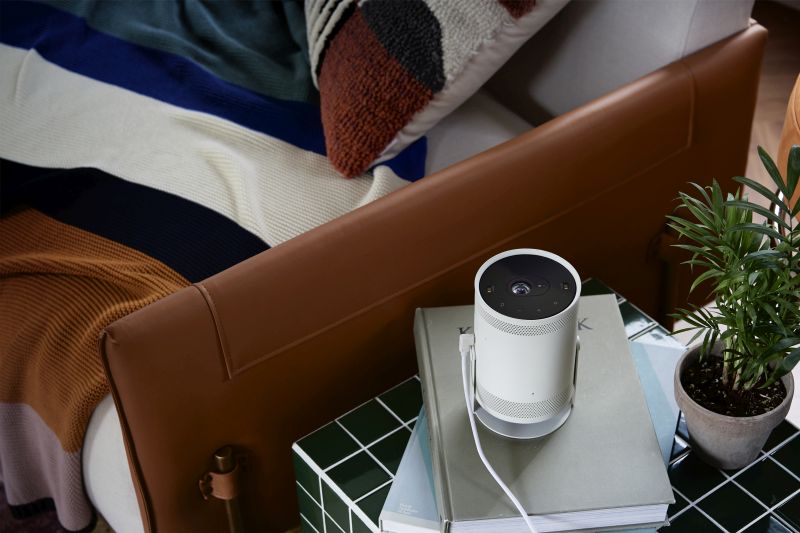
HDR Viewing. HDR is a welcome capability on this projector, even if it's a little bit limited by the lack of 4K support. The most important thing to know is you won't see any benefit of HDR when projecting a large image; it's simply not bright enough. But as I touched upon already, one of the compelling applications for The Freestyle is projecting a small image wherever you need it. And when you go small, the picture gets bright and what you see is a real treat for the eyes. I believe the term for it is "eye candy."
This is a new paradigm, a projector that isn't all that bright in terms of ANSI lumens but otherwise focuses so strongly on picture quality that it possesses attributes you associate with flat-panel displays, at least when projecting at smaller screen sizes—for example, the "piece of paper" 22-inch "monitor" I described above. At that size, 415 nits of peak luminance go right to work, making 1080p HDR look quite vivid, at least compared to PC monitors and entry-level HDR TVs. On the other hand, if you try to project a 75-inch diagonal image, those peak luminance levels drop precipitously, to only 44 nits with calibrated Movie mode color, or around 55 nits in Standard mode with Brightness set to maximum. Notably, brightness at 75 inches is almost perfect for home theater-style viewing of SDR content, just not for HDR. The "beyond Rec.709" yellows, reds, magentas, and blues found in HDR content can take some advantage of the projector's capabilities. But in the end, HDR is not a big selling point for this projector because of the limited brightness at larger screen sizes. Still, it processes HDR source material well, although it is frustrating not to be able to downscale 4K HDR source material, like with a gaming console.
Game Viewing. Turn on Game Mode, and The Freestyle shuts off extraneous picture processing to deliver 43.2-millisecond input lag. While a 1080p/60 Hz gaming display is pretty far from state-of-the-art these days, what I found is that my gaming devices—a PlayStation 4 Pro, Xbox Series X, and an RTX 2080 SUPER-equipped 12-core gaming PC—all had the easiest time with that resolution and frame rate. I max out all the image quality settings on my PC, and the result looks almost as good as 4K from my PlayStation 4 Pro. And on all three machines, maintaining a solid and smooth 60 Hz frame rate didn't even cause the devices to break a sweat.
There's really not much to discuss here beyond what was described under SDR viewing, except to say that video game graphics don't need motion enhancement or noise reduction, so those features were not missed in any way. Video games look detailed and vibrant with the Standard color tone setting that is the Game Mode default, and even more wonderful when the projector is fully calibrated with a 2-point adjustment (10-point and 20-point are not available in this mode).
Some gamers will surely complain that the 43.2 ms input lag is too much, which is an accurate observation for competitive gaming. Still, it is fast enough to feel good for casual gaming, and it did not hinder my ability to play at a high level in Grand Theft Auto Online. The Freestyle even got me thinking about how I might fit a PlayStation and the projector inside a backpack and take it all with me. It's important to remember this is not designed or marketed specifically as a gaming projector, but it is perfectly usable.
Have a Projector Question?
Join our free ProjectorCentral Facebook Group to get answers quickly.
Check it Out
Judging by my go-to games—Forza 5 on the Xbox series X and Grand Theft Auto Online on the PlayStation 4 Pro—this projector is a solid choice for the sort of screen sizes popular among gamers, typically between 32 and 48 inches. At those sizes, you get sharp, fluid, and punchy 1080p/60 Hz SDR that can cut through modest amounts of ambient light and looks really contrasty yet detailed, from shadows to highlights. Dim the lights, and frankly, it looks awesome at smaller sizes, but just like with movies, you have to play in a dark room if you want to project a 70-inch picture or larger.
Ambient Mode. One big differentiator with this projector and any competitor that I'm familiar with is its Ambient Mode and the lighting effects achievable with or without the provided translucent lens cap. The lens cap transforms the projector into an interactive smart lamp that can create changing and evolving ambient light effects to evoke various moods. This is all controllable with Samsung's SmartThings app.
Within Ambient Mode are various scenes, for example, "banners" that say Happy Birthday or Happy New Year, etc. Organizing a surprise party? You don't need a paper banner you'll just throw away; you can just project the sentiment on a wall or ceiling instead, and it's plenty readable in a bright room.
There are effects you use in conjunction with the translucent lens cap. I want to say that it has a little bit of the lava lamp flavor to it; you could dim the rest of the lights and bliss out on the soft, organic, changing, colorful diffuse patterns put out by this cool little projector. Of course, you can also have it play music simultaneously, so simple relaxation and meditation are among the potential uses. And while it would be extravagant to have multiple Freestyle projectors acting as ambient lights in the same room, it would also be unbelievably awesome. Once you free your mind of what you normally expect from a projector, the ingenuity of Samsung's design becomes apparent. It's not just a projector and a smart speaker; it's also a smart lamp with the ability to put on fancy light shows. Can your projector do that?
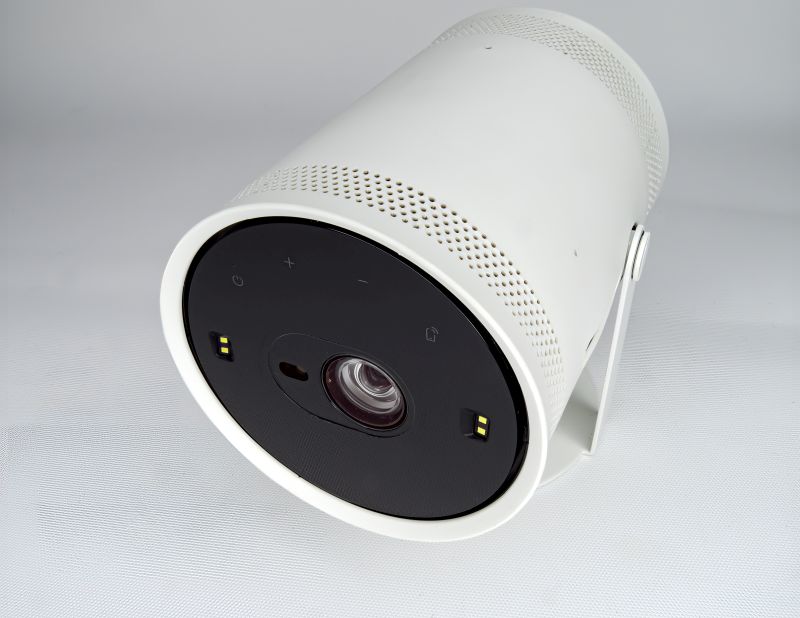
Another Ambient Mode option is to upload your own photos and create a slideshow. When you create a slideshow, the projector downloads the content locally, so you can then choose it with the remote and not be dependent on your phone. I can see artists, photographers such as myself, perhaps, using a bunch of these to create an impromptu gallery for a pop-up art show. There are just so many possibilities when you are serving up the content wirelessly, and the projectors are so small, light, and adaptable.
Want more? There are animated scenes as well. Want a starfield? You got it. A fireplace? Of course. Also, it can simulate a window view with the aurora in the night sky, or perhaps snow-covered trees with falling flakes for Christmas. Want something psychedelic? The Freestyle Ambient Mode has that as well, with numerous animated kaleidoscopic patterns available under the prism section. In all, the ambient mode is a fun extra.
Audio/Smart Speaker. Considering its size, the audio performance of The Freestyle is fairly heroic. Nobody will mistake it for a surround sound system or even a decent soundbar. However, I could easily see it mistaken for a smart speaker like an Amazon Echo based on size and sound quality. Because it possesses a far-field microphone array, it behaves just like a dedicated smart speaker from Google or Amazon—except that it can do so much more, which is why this device could be seen as the most feature-packed smart speaker you can buy.
I wish that Samsung had included a 3.5mm aux input; I feel there's still a place in this world for a simple analog input on any AV device. Nevertheless, I was able to use the HDMI input to send some test tones to the projector from Room EQ Wizard and measure the result using a miniDSP UMIK-2 calibrated microphone. What I saw is a speaker that, despite its diminutive size, can cover a frequency range of 80 Hz to 20 kHz cleanly, though at higher volume levels there's some audible distortion in bass below 80 Hz. The ultimate cutoff appears to be around 60 Hz, below which there's basically no output.
My main observation about the speaker is that it offers a very good tonal balance, and as a result, it reproduces speech clearly and sounds neither thin nor bloated. The main limitation is output, which is no surprise because the laws of physics make it difficult to design a small speaker that plays loud and has deep bass all at once. The Freestyle finds a good balance between these requirements. It is especially effective when the projector is in front of you and shining on the wall, in which case the rear-firing speaker is pointed at the viewer, which results in maximum volume and optimal total balance.
Ultimately, the audio performance was sufficient to watch YouTube clips and play video games. It's also great for background music, but I would not rely upon it as a primary sound system.
Conclusion
After a week of using and reviewing the Samsung Freestyle, I concluded that I love this thing. Sure, there is a rational projector reviewer in me that says it's "just" a modestly capable, 1080p compact projector with a particularly good focusing mechanism, sharp lens, and a great smart OS. But there is also a kid in me that says, "Hey, this thing is really awesome, you've never really seen anything quite like it, and you wish you owned one."
The latter sentiment never went away throughout the review. Instead, it evolved into the more adult view of "Hey, I could use this thing to do a bunch of cool stuff that I'm not doing right now." Taken as a whole, it represents an interesting evolution of projection into a more lifestyle-friendly, family-friendly device than ever before. The projector is equally at home in the kitchen, bathroom, basement, bedroom, living room, or at a campsite, or while visiting a friend's house or shining a message on the ceiling of some banquet hall. Once you have a projector this robust and adaptable, the creative possibilities begin to unfold. I suspect that the novel uses for The Freestyle will soon begin to appear on social media, and the device's full potential will not be known until TikTok has had its way with it.
I'm giving The Freestyle a Highly Recommended nod. There's a caveat in that it's not recommended for every single use case you can think of—primarily, due to its brightness limitations, it won't replace a TV in a bright room, and it's no 4K HDR reference home theater projector, either. But if nothing else, it deserves the award designation for how well it serves as a small to medium-size display, especially factoring in its color accuracy, and for all the cool use cases that we can't even think of right now. And consider this: I haven't even covered everything Samsung says you can do with it.
Remember when the smartphone first came out? It seemed so new because it took existing things and compellingly repackaged them in one place. The Freestyle is basically the smartphone of projectors.
Measurements
Samsung The Freestyle ANSI Lumens
| Mode | Lumens |
|---|---|
| Dynamic | 234 |
| Standard | 234 |
| Movie | 188 |
| Game Mode | 234 |
Brightness Uniformity: 91%
Fan noise. The Freestyle's fan is like a laptop fan; it's virtually silent, and the airflow is so slight you don't notice it even with your head up close to the unit. I can hear it if I put my ear right next to the chassis, but I could only barely measure it from one meter away, and only if I drop the noise floor in my room to 35 dB by turning off all fans and appliances. In this condition, the real-world measurement essentially equaled or (perhaps fell just below) the noise floor at 35dB from a position behind the projector (toward the seat) using a miniDSP UMIK-2 and Room EQ Wizard software and dB-A weighting. Subjectively, one meter away is also where I can barely start to make out the fan if the room is silent. It's a very quiet projector.
Input Lag. With a Bodnar lag meter, I measured the input lag for 1080p/60p SDR at 43.2 milliseconds, not bad for a DLP that isn't specifically optimized for gaming.
Connections
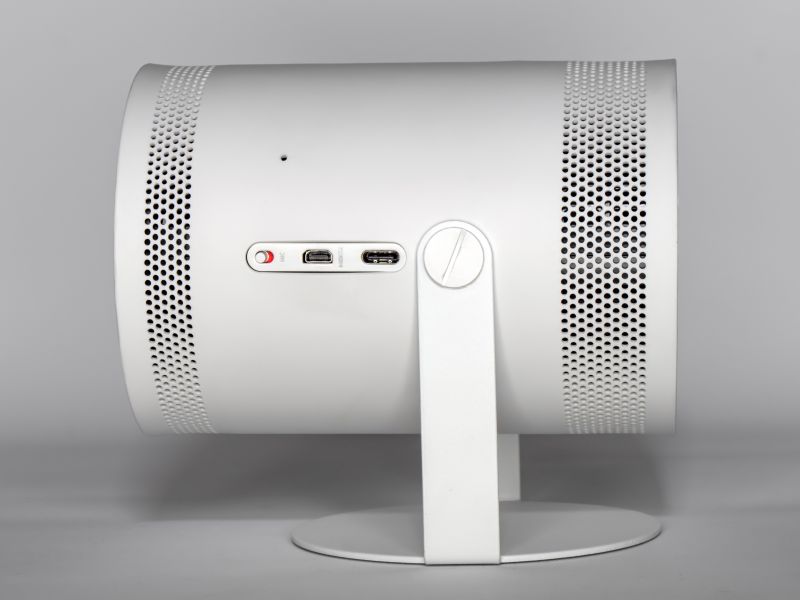
- Micro HDMI (Version 1.4)
- USB- C (for power)
- Wireless Networking
- Bluetooth audio out
Calibrated Settings
Calibrated image settings from any third party do not account for the significant potential for sample-to-sample variation, nor the different screen sizes and materials, lighting, lamp usage, or other environmental factors that can affect image quality. Projectors should always be calibrated in the user's own space and tuned for the expected viewing conditions. However, the settings provided here may be a helpful starting point for some. Always record your current settings before making adjustments so you can return to them as desired. Refer to the Performance section for some context for each calibration.
SDR and HDR
Picture Mode: Movie
Brightness: 50
Contrast: 35
Sharpness: 0
Color: 25
Tint: 0
Noise Reduction: On
Motion Compensation: Judder Reduction 3
Contrast Enhancer: Low
Color Tone: Warm1
White Balance: 2-Point
Gain
Red: -15
Green: -17
Blue: 6
Offset
Red: -2
Green: 1
Blue: 2
For more detailed specifications and connections, check out our Samsung Freestyle projector page.
To buy this projector, use Where to Buy online, or get a price quote by email direct from Projector Central authorized dealers using our E-Z Quote tool.
The Logitech Brio is a USB device, so it would need to be connected to a PC and then the projector connected to the PC's HDMI out for that to work. But, any camera that has an HDMI output could provide a live 1080p feed to the projector and that could include a cellphone with an HDMI multimedia adapter.




